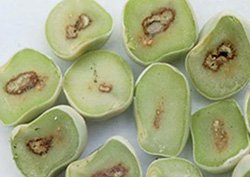 Full
FullGuide »

January 2025
Manganese Deficiency & Marsh Spot
A deficiency or unavailability of the trace element manganese can cause a reduction of yield in both vining and combining peas and may result in the appearance of marsh spot, a disorder that affects the seed, and reduces produce quality for human consumption and affects germination of seedlings.
OCCURRENCE AND SYMPTOM
The disorder is commonly associated with organic soils, although crops on other soil types can also be affected. Peas grown on soils with a pH greater than 6.8 are more susceptible to deficiency, especially in wet or compacted conditions, when manganese becomes unavailable to the plants and is locked-up in the alkaline soil. Over liming must be avoided. Heavily trafficked areas, such as wheelings, cause compaction, and symptoms of manganese deficiency can often be seen as pale coloured lines running through a crop. Manganese deficiency causes a yellowing around the leaf edges and between the veins. Entire leaves may become yellow in time, but the veins and the areas of tissue adjoining them are the last to lose their green colour, giving a somewhat striped appearance to the leaf. Affected plants are likely to produce peas which have a brown or granular necrotic area in the centre of the cotyledons and this condition is known as marsh spot. Such produce is unsuitable for processing due to the physical blemish, or for use as seed, as the spot affects the plumule and gives rise toabnormally developed seedlings.
TREATMENTS
Treat crops which are:
• Growing on land known to have a history of manganese deficiency.? Growing on land of pH 6.8 or more as a routine, spraying at the 1st pod stage and again 10-14 days later.
In addition:
• During wet weather flowering may be prolonged and a third application may be beneficial.
• Crops in which symptoms are seen should be sprayed immediately and treatment repeated at the 1st pod stage andabout 10 days later still.
Treat with manganese sulphate (32% manganese) at 5 kg/ha in a high volume of water with an added wetter. Trials have shown that other products containing a high percentage of manganese are also effective. However, sprays with chelated forms (6% manganese) do not contain enough manganese to give adequate control.

COMBINED TREATMENTS
Sometimes, treatment against manganese deficiency coincides with treatment against pea moth or pea aphid or with a fungicide. Certain insecticides and fungicides can be mixed, but before doing so, the manufacturers of the products must be consulted.